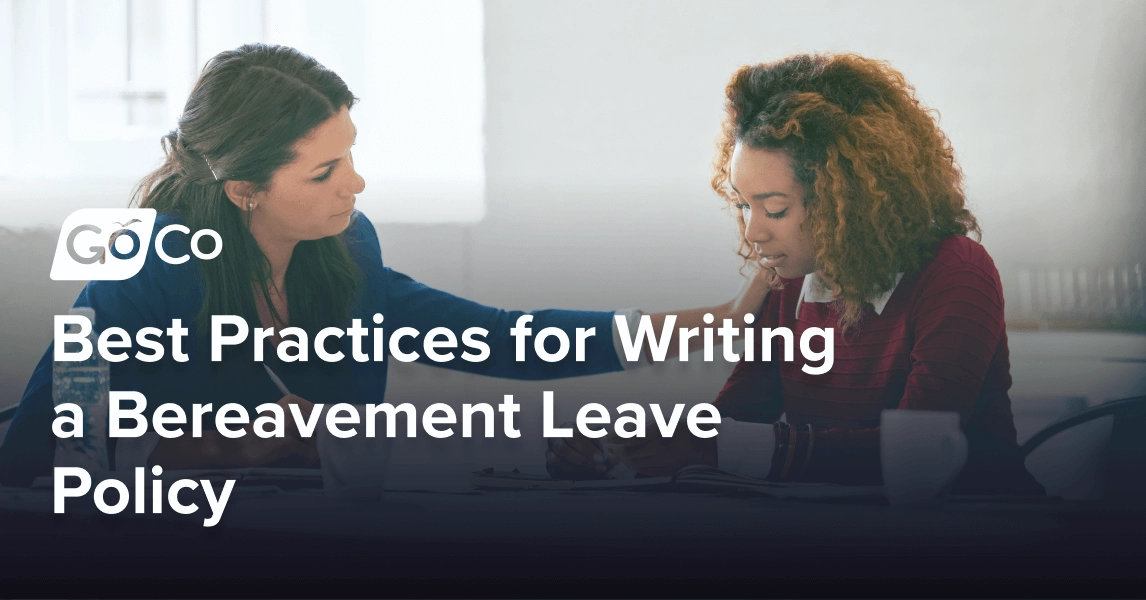Best Practices for Writing a Bereavement Leave Policy in 2025
Make your bereavement leave policy work for today’s workforce. See what top employers offer and how laws are changing in 2025.
by Anna Coucke - April 2nd, 2025
Grief is an emotion that is extremely difficult to navigate. When we mourn the loss of loved ones, we are at our most vulnerable state, and the last thing on our minds is work. That’s why it’s the responsibility of human resources and leadership to establish clear and inclusive policies and processes that adequately support employees in the event of great loss.
Whether an employee experiences the death of a family member, friend, or partner, make sure your organization can offer condolences as well as actionable support. Consider the following practices and policy implementations to strengthen your employee support system.
Table of Contents
- Why Bereavement Leave Policies Matter for Employee Well-Being and Retention
- Bereavement Leave Statistics and Industry Benchmarks
- Which States Have Bereavement Leave Laws?
- How To Create a Bereavement Leave Policy
- Why Flexible Bereavement Leave Policies Improve Employee Trust and Morale
- Providing Mental Health and Grief Support for Bereaved Employees
- Final Thoughts
Why Bereavement Leave Policies Matter for Employee Well-Being and Retention
Grief is becoming a crisis in the US. Most US workers only receive three days for the bereavement of a close family member, and there is no federal law giving workers paid time off for bereavement or for attending a funeral.
In addition to the time needed for their own emotional support process, many workers will also need to manage logistics, arrangements, funeral planning, attendance, critical paperwork, and beyond. To do that in three days is nearly impossible, and some workers don’t even receive that!
Fortunately, at the organizational level, many HR leads are carving out their own policies for their employees. We’ve written on equitable bereavement policies more broadly, but for many HR teams, it’s difficult to determine which is the best policy for their organization. After all, what’s common in nonprofits may be completely different in retail, for example.
Therefore, this article will focus more on bereavement leave trends and policies to help HR determine the standard amount of leave based on their business and how it might look different for different industries.
Bereavement Leave Statistics and Industry Benchmarks
According to research conducted by NFP, standard policies often look like the following:
68% of survey responders offered 1-3 days of bereavement leave for immediate family members, while 28% offered 4-7 days.
45% of responders offered 1-3 days for non-immediate family members, while 6% offered 4-7 days.
20% of responders offered 1-3 days for family friends or close friends.
Only 3% of responders offered bereavement leave for pets.
By sector, responders reported the following:
76% of government contractors offered 1-3 days for immediate family members, 18% offered 4-7 days for immediate family members, and 37% offered 1-3 days for non-immediate family members.
65% of nonprofits or associations offered 1-3 days for immediate family members, and 31% offered 4-7 days for immediate family members. 39% offered 1-3 days for non-immediate family members, and 10% offered 4-5 days for non-immediate family members. 18% offered 1-3 days for family friends or close friends.
65% of commercial organizations offered 1-3 days for immediate family members, and 34% offered 4-7 days for immediate family members. 55% offered 1-3 days for non-immediate family members, and 28% offered 1-3 days for family friends or close friends.
Which States Have Bereavement Leave Laws?
While there are no federal laws for bereavement leave, some U.S. states have enacted legislation surrounding job-protected bereavement leave, including several with legislation currently in progress:
California
Effective January 1, 2023, California law mandates that employers with five or more employees provide up to five days of bereavement leave upon the death of a family member. This leave is unpaid unless the employer has an existing paid bereavement leave policy. Employees must complete the leave within three months of the family member's death and may be required to provide documentation, such as a death certificate.
Illinois
The Family Bereavement Leave Act, effective January 1, 2023, entitles eligible employees to up to two weeks (10 workdays) of unpaid bereavement leave. This leave covers attending the funeral of a covered family member, making necessary arrangements, or grieving. The Act also includes leave for pregnancy loss, failed adoptions, unsuccessful reproductive procedures, and other diagnoses or events negatively impacting pregnancy or fertility.
Maryland
Maryland mandates that employers with 15 or more employees allow the use of accrued paid leave for bereavement purposes under the Maryland Flexible Leave Act (MFLA). This law permits employees to utilize their earned paid leave, such as sick or vacation time, for the death of an immediate family member (child, spouse, or parent).
Oregon
Under the Oregon Family Leave Act (OFLA), eligible employees can take up to 2 weeks of unpaid, job-protected leave per family member’s death, capped at 4 weeks per year. This leave must be used within 60 days of receiving a death notice. Covered family members include spouses, children, parents, siblings, grandparents, grandchildren, and anyone with a close relationship equivalent to family.
To be eligible for leave under this law, the employer must have at least 25 employees, and the employee must have worked for the same employer for at least 180 days, averaging a minimum of 25 hours per week. OFLA does not require paid leave, but employers may offer it voluntarily.
Washington
Washington state law provides employees with up to three days of paid bereavement leave upon the death of a family member or household member. Employers may require verification of the family member's or household member's death.
States with Bereavement Leave Legislation in Progress
As of April 2025, the following states currently have legislation surrounding bereavement under consideration:
New Jersey
New Jersey is considering Assembly Bill 3505 (A3505) and Senate Bill 2978 (S2978) to amend the state's Family Leave Act and Temporary Disability Benefits Law. These bills aim to provide employees with protected leave and temporary disability benefits for bereavement purposes, including:
Death of a child
Miscarriage or stillbirth
Termination of pregnancy for medical reasons.
Unsuccessful adoption
Failed fertility treatments
The proposed legislation specifies that employees may take up to 21 days of leave immediately following the event for bereavement related to circumstances not covered by existing leave or benefits. For events already eligible under current laws, the leave is limited to seven days. Any benefits paid under these provisions would be through family temporary disability leave, without increasing the maximum amount of leave provided by existing laws.
North Carolina
On November 1, 2024, Governor Roy Cooper signed Executive Order 325, establishing a Bereavement Leave program for eligible state employees within cabinet agencies. Other state agencies, universities, commissions, boards, or offices may choose to adopt the policy for their employees.
As of March 26, 2025, North Carolina Senate Bill 549 has been introduced to provide state employees with paid leave designated for bereavement and following a pregnancy loss. The bill proposes granting permanent, probationary, or time-limited full-time state employees not less than 56 hours of paid leave for pregnancy loss.
Massachusetts
Massachusetts lawmakers are advancing multiple bereavement leave bills in the 2025–2026 legislative session, with multiple bills introduced in February 2025:
H.2189 proposes up to 10 business days of job-protected bereavement leave following the death of a family member. Employers with 25+ employees would determine whether the leave is paid or unpaid. Effective date: January 1, 2027.
S.1287 and S.1354 (introduced by Senators Barrett and Miranda) both aim to establish statewide bereavement leave but currently lack specific duration or provisions.
H.2064 focuses on bereavement leave specifically for the loss of a child.
Vermont
Vermont is considering the following legislation to expand job-protected leave to include bereavement:
H.461 proposes allowing employees to use up to 2 weeks of their 12-week unpaid family and medical leave for bereavement. The bill also covers leave for domestic violence, stalking, and other exigencies.
H.459 would amend existing law to prevent employers from requiring bereavement or family leave to run concurrently with other paid leave, offering employees more flexibility.
Both bills were introduced in March 2025 and are currently under committee review.
How To Create a Bereavement Leave Policy
While some states now have set laws, there is no federal requirement for companies to provide bereavement leave for grieving employees. However, even if your state doesn't have bereavement leave requirements, you absolutely should consider putting a bereavement leave policy in place, both to set your organization apart from those who don't and also to support your employees' well-being.
1. Define The Basics
The first step is to create a Bereavement Leave Policy that answers any and all questions employees could have about the logistics of their situation from a work point of view. Be sure to include:
If leave will be paid, unpaid, or a mix. Best-in-class companies offer additional PTO beyond sick/vacation days.
A standard duration (e.g., 3–5 days for immediate family, 1–2 for extended family or friends) but build in flexibility.
Clarification on who qualifies for leave — full-time, part-time, and/or contractors.
Your policy should be well-documented, accessible, and free of ambiguity. Outline all key components: the number of days offered, whether the time off is paid, which relationships are covered, eligibility criteria, and how leave can be requested.
Don't forget to explain how the policy interacts with other types of leave. For example, you might note that bereavement leave is offered in addition to standard PTO and resets every calendar year. A clearly written policy reduces confusion and ensures consistent treatment across the organization.
2. Be Inclusive When Defining "Family"
When creating your policy, avoid limiting bereavement to a narrow list of relationships. Restrictive policies can alienate employees who are grieving deeply for non-traditional or chosen family members.
Instead, consider a broad definition that includes not only immediate family, but also extended relatives, close friends, domestic partners, and relationships equivalent to family. Also be sure to consider parental loss, such as miscarriage, stillbirth, or failed adoption. A more inclusive policy ensures you’re not signaling that only certain types of grief are valid.
3. Simplify The Request Process
Once you have set your policy definitions and timeframes, make it easy and private for employees to request bereavement leave. They should be able to do so without disclosing more than they’re comfortable sharing.
Ideally, your HR system should support categorizing the leave request under “bereavement” or “personal leave,” and route it to the appropriate manager or HR contact. Platforms like GoCo allow for this streamlined process — employees can submit requests digitally, managers receive automatic notifications, and timesheets update in real time, reducing administrative friction.
Respect for privacy during this process is critical. Some companies require documentation such as a death certificate, but this practice can feel intrusive and dehumanizing. Unless legally necessary, avoid asking employees to prove their loss. Instead, support your managers with tools and workflows that guide them through the necessary administrative steps — approving leave, adjusting payroll, and updating schedules — without making grief a bureaucratic burden.
4. Offer Flexibility Beyond the Policy
Each situation is unique, and there is no one-size-fits-all approach to grief. Your set bereavement leave period may not be enough in some cases. What will set you apart as an employer is your willingness to work with your employee and find an arrangement that works for both of you!
While it’s important to have a standard policy, be sure to make room for flexibility. Encourage managers to approve additional leave if the circumstances warrant it, especially for major losses like the death of a child or in the case of complicated estate matters. Be open to letting employees use other types of leave or work out temporary flexible arrangements. Showing a willingness to adapt demonstrates that your organization prioritizes people over rigid processes — and that goes a long way in building trust and loyalty.
Why Flexible Bereavement Leave Policies Improve Employee Trust and Morale
In addition to the obviously devastating emotional impact of death, there are also costs in the form of time and money. With unexpected death, getting affairs in order can take a significant amount of time, and funerals can be extremely expensive. During a time of such hardship, we cannot stress enough just how helpful it is when your employees aren’t weighed down by the fear of professional obligations and/or consequences.
Each situation is unique, and there is no one-size-fits-all approach to grief. Your set bereavement leave period may not be enough in some cases. What will set you apart as an employer is your willingness to work with your employee and find an arrangement that works for both of you!
Providing Mental Health and Grief Support for Bereaved Employees
Supporting employees through grief requires more than time off. Beyond providing leave, consider partnering with resources that provide emotional help and guidance for your employees should they find themselves in these circumstances. Consider implementing the following:
Employee Assistance Programs (EAPs): Provide confidential access to short-term counseling, legal support, and financial advice. Make sure the program includes grief-specific resources and 24/7 availability.
Free or Subsidized Therapy: Partner with mental health providers to offer sessions at reduced or no cost. Covering the full cost removes financial barriers during a vulnerable time.
Manager Training: Train managers to recognize signs of grief and mental distress, offer compassionate support, and connect employees with appropriate resources without overstepping boundaries.
Wellness Stipends: Offer monthly or annual stipends that employees can use toward wellness services of their choice, including therapy, meditation, massage, or grief coaching.
Internal Resource Hubs: Create a centralized location (digital or physical) with grief-related resources, including mental health services, articles, podcasts, and community referrals.
Offering varied options helps ensure employees can access the kind of support that works best for them, whether that's clinical care, peer connection, or space to reflect. Going beyond the bare minimum sends a strong message that you value your team’s humanity, not just their output.
Final Thoughts
Bereavement is one of the most difficult experiences an employee can face, and the way your company responds speaks volumes about your values. A well-crafted bereavement leave policy isn’t just an HR best practice; it reflects your organization’s commitment to treating people like people. By offering inclusive, clearly defined, and easily accessible leave, you help employees focus on healing, not logistics.
The administrative side of leave management doesn’t have to be complicated. GoCo’s all-in-one HR platform simplifies every aspect of bereavement leave — from secure request submissions to automated approvals and timesheet adjustments — so your team can focus on what truly matters: supporting each other during life’s hardest moments.
Ready to make your bereavement leave process more compassionate and efficient? Book a free demo with GoCo to see how we can help you build a people-first workplace without the administrative burden.
Frequently Asked Questions (FAQs)
-
No federal law requires bereavement leave. However, California, Illinois, Maryland, Oregon, and Washington have enacted state-level laws. Several other states, including Massachusetts, New Jersey, North Carolina, and Vermont, have active legislation under consideration as of April 2025.
-
Best-in-class organizations offer paid bereavement leave in addition to PTO. In states like California and Washington, leave may be unpaid unless the employer chooses to compensate. Organizations looking to support employee well-being and retention should strongly consider offering paid leave.
-
Eligibility often includes full-time employees and may extend to part-time or contract workers at the employer's discretion. Inclusive policies also cover a broader definition of “family,” including close friends, domestic partners, chosen family, and pregnancy loss (e.g., miscarriage, stillbirth, failed adoption).
-
Unless required by law, the best practice is to avoid documentation such as death certificates. It can feel invasive. Instead, build trust by streamlining requests and training managers on sensitive approval workflows.
-
Yes. While setting a baseline is essential, employers should allow managerial discretion to extend leave based on the circumstances. Supplement with PTO or flexible arrangements if needed.
Updated 4/2/2025
Recommended Posts
Everything Your HR Team Needs to Know About PTO in 2025
Blog Articles
HR’s Guide to Employee Benefits Administration
Blog Articles
Paid Parental Leave Policies for Small Businesses
Blog Articles
Search...
Product
GoCo
Resources
Articles
eBooks
Webinars
Customer Stories






